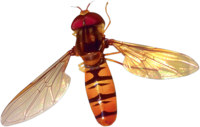Half the Population Has Genes to Make Them Fat

I have talked a bit about my skepticism concerning the genetic contribution to obesity, insulin resistance and diabetes.
I was fascinated to see a huge fifteen year study that has just been published in the journal Science. I felt a touch of pride: back when the earth was new, I helped train more than one of the authors.
The study involved over 42,000 people and found an association with body mass index at every age [from seven to 70] in populations throughout the UK and Europe.
Unlike previous work, it shows a very common genetic link with mild obesity rather than a rare genetic link with extreme obesity.
There were 42 scientists in the group and they found that if people carry one copy of a variant in a gene called FTO, as does half of the general population, it will lead to a gain in weight of 2.6lb or put just over half an inch on their waists and raise their risk of being obese by one third. People with two copies of this variant in the FTO gene, which is the case in one in six of the population, then they will gain almost 7lb more than those who lack the variation and are at a 70 per cent higher risk of obesity.
The researchers then tested a further 37,000 people from Bristol, Dundee and Exeter as well as a number of other regions in Britain, Italy and Finland. In every case the same variant in the FTO gene – which is mostly present in the brain and pancreas, among other key tissues – was associated with type 2 diabetes and obesity.
They also showed that in children, this particular FTO variant was associated with increased body weight.
We hope that in the future, once we have found additional obesity genes, it may be possible to offer advice based on a person’s genetic make-up. We all know that folk are eating more and doing less exercise, but some people gain more weight than others. Similarly two people on the same diet and exercise plan lose different amounts of weight. There are undoubtedly some unrecognized factors in weight gain, but genes remain in the mix.
Never be disheartened if your first attempt at diet and exercise is not crowned with success: they are only two of a dozen factors that play into weight control.
Do not fall into the fatalistic trap of thinking that biology is destiny.
We are talking about a factor that may modulate the way in which we control out weight.
As promised, I shall soon be publishing a book detailing specific methods for dealing with whichever ones are important in your life.
Your future lies in your hands: not in a string of chemicals.
Mastering Chess: Genes or Environment?

It is always interesting to look at people who have excelled at something to see what we can learn.
I recently talked about the new research indiating that there are some genes that have some impact on intelligence.
There is an interesting article in today’s New York Times, entited, “Nature? Nurture? Never Mind. Here’s a Sister Act to Watch,” by Dylan Loeb McClain. He has this to say:
“Siblings who are elite chess players are rare. The best known are probably the Polgar sisters of Hungary. Susan, the eldest, is a grandmaster and former women’s world champion. Sofia is an international master. And Judit, the youngest, is the best woman player in history.
Other notable chess-playing siblings have included the Byrne brothers, Robert, a grandmaster and the longtime columnist for The New York Times, and Donald, an international master who died at 45; and Gregory Shahade, an international master, and Jennifer Shahade, a two-time United States women’s champion, who were taught chess by their father, Michael, a master.
Why so few elite sibling players? Is it simply because it is highly unlikely for a single family to produce multiple elite players? Or do most siblings have different interests?
The questions go to the heart of a familiar debate: Is chess talent innate or nurtured?
In his popular book “The Immortal Game,” David Shenk said great chess players were made, not born, writing, “Cognitive chess research punctured the longstanding myth of the chess prodigy, the born genius.”
The best players, Shenk wrote, are the product of intensive study and training. He said the Polgar sisters, who were raised by their father, Laszlo, from an early age to be chess players, were a prime example.
Shenk recounts an episode years ago in which Susan was studying with an international master and they had a problem they could not solve. They woke up young Judit, who, half-asleep, found the solution immediately and went back to bed.
Aren’t the varying levels of talent among the Polgar sisters, who all presumably had the same training, evidence of innate differences? Possibly.
A pair of sisters who have been making a big splash lately do not seem to be separated by ability, at least so far. Nadezhda and Tatiana Kosintseva of Russia are ranked No. 14 and No. 24 in the world among women. But at the European championships, which concluded April 15, Tatiana ran away from a large field, finishing two points ahead of her sister.”
There is undobtedly some set of genes that increase the chance that someone will be good at some game or other, whether it is chess or golf. But there is also the family, school or club that can help someone to realize their true potential.
But even if the genes aren’t all there, you can still become highly competent if you have learned how to learn and if you have learned the arts of patience, perseverance and persistence.
Biology is not destiny!
Genius Genes

I have talked before about the fascinating topic of child prodigies, and the continuing debate about the contributions and interactions of nature and nurture.
There is an important new study published in the journal Behavioral Genetics that should be of interest to anyone interested in thinking, intelligence and optimizing the potential of children.
A team of researchers from Washington University School of Medicine in St. Louis, has gathered the most extensive evidence to date that a gene that activates signaling pathways in the brain influences at least one kind of intelligence. They have confirmed a link between the gene, CHRM2 and performance IQ, that involves a person’s ability to organize thoughts or events logically.
The team found that several variations within the CHRM2 gene could be correlated with slight differences in performance IQ scores, which measure a person’s visual-motor coordination, logical and sequential reasoning, spatial perception and abstract problem solving skills. When people had more than one positive variation in the gene, the improvements in performance IQ were cumulative.
Typical IQ tests also measure verbal skills and typically include many subtests. For this study, subjects took five verbal subtests and four performance subtests, but the genetic variations influenced only performance IQ scores.
The researchers studied DNA gathered as part of the Collaborative Study on the Genetics of Alcoholism (COGA). In this multi-center study, people who have been treated for
alcohol dependence and members of their families provide DNA samples and investigators have isolated DNA regions related to alcohol abuse and
dependence as well as a variety of other outcomes.
Some of the participants in the study also took the Wechsler Adult Intelligence Scale-Revised, a traditional IQ test. Members of 200 families, including more than 2,150 individuals, took the Wechsler test, and those results were matched to differences in individuals’ DNA.
By comparing individual differences embedded in DNA, the team focused on CHRM2, a muscarinic receptor gene on
chromosome 7. The CHRM2 gene activates a multitude of signaling
pathways in the brain involved in learning, memory and other higher
brain functions. The research team does not yet understand how the gene
exerts its effects on intelligence.
Intelligence was one of the first pscyhological factors that attracted the attention of people interested in the interplay of genes and environmental influences. Early studies of adopted children showed that when children grow up away from their biological parents, their IQs are more closely correlated to biological parents, with whom they share genes, than adoptive parents, with whom they share an environment.
But in spite of the association between genes and intelligence, it has been difficult to find specific variations that influence intelligence. The genes identified in the past were those that had profoundly negative effects on intelligence – genes that cause mental retardation, for example. Those that contribute to less dramatic differences have been much harder to isolate.
The St. Louis team is not the first to notice a link between intelligence and the CHRM2 gene. In 2003, a group in Minnesota looked at a single marker in the gene and noted that the variation was related to an increase in IQ. A more recent Dutch study looked at three regions of DNA along the gene and also noticed influences on intelligence. In this new study, however, researchers tested multiple genetic markers.
The lead investigator in St. Louis, Danielle Dick, had this to say,
“This is not a gene FOR intelligence, it’s a gene that’s involved in some kinds of brain processing, and specific alterations in the gene appear to influence IQ. But this single gene isn’t going to be the difference between whether a person is a genius or has below-average intelligence.”
“One way to measure performance IQ may be to ask people to order pictures correctly to tell a story. A simple example might be pictures of a child holding a vase, the vase broken to bits on the floor and the child crying. The person taking the test would have to put those pictures into an order that tells the story of how the child dropped the vase and broke it and then cried.”
“If we look at a single marker, a DNA variation might influence IQ scores between two and four points, depending on which variant a person carries. We did that all up and down the gene and found that the variations had cumulative effects, so that if one person had all of the ‘good’ variations and another all of the ‘bad’ variations, the difference in IQ might be 15 to 20 points. Unfortunately, the numbers of people at those extremes were so small that the finding isn’t statistically significant, but the point is we saw fairly substantial differences in our sample when we combined information across multiple regions of the gene.”
Most experts believe that there are at least 100 genes that could influence intelligence, but it is unlikely that any one gene is going to be the ONE determinant of how smart someone is. After all, IQ itself has very poor predictive value for anything much in life apart from achievement in high school. The many genes involved probably have small, cumulative effects on increasing or decreasing IQ, and the key will be to understand the interaction between environmental influences and these genes. We already know that childhood nutrition, socio-economic status and emotional and cognitive environments have a profound influence on intelligence and achievement. Altogether too many children have all the mental machinery but do not even realize the possibilities open to them.
It is also clear that early influences will have a lot to do with the repertoire of intelligences that a person has. In the book and CD series Healing, Meaning and Purpose I spend some time discussing Howard Gardner’s important concept of multiple intelligences. Many of us have skills in certain domains and it is a terrible mistake to assume that because a child is not very good at logical or verbal tasks, that they are not smart. After all, how many brilliant musicians, computer scientists and entrepreneurs never finished high school or college?
There is clearly more than a gene deciding our intelligence and success at certain activities. The genes may give us the machinery and the fuel, but there are clearly many other factors. I’ve always been a very keen chess player and I once had a friend who was a nationally ranked contract bridge Master. He would destroy most normal mortals at any card game: including me! Even when we played scratch games of contract bridge he would always try to avoid partnering me: he told me that I sucked too badly! 8-(
He also had a hobby: he built and designed all kinds of board games. He used to get upset that whatever the game, if it was played on a board, I almost always won. But here’s the interesting thing: our IQs were virtually identical. But he was murderously good at card games but not at anything involving a board: another refinement of intelligence. I probably did well with board games because I could plan and visualize in three dimensions. My friend had a phenomenal memory for cards that I simply don’t possess.
As the owners of some establishments in Las Vegas once discovered to their glee….
“Intelligence is quickness to apprehend as distinct from ability, which is capacity to act wisely on the thing apprehended.”
–Alfred North Whitehead (English Mathematician and Philosopher, 1861-1947)
“Intelligence is the ability to find and solve problems and create products of value in one’s own culture.”
–Howard Gardner (American Psychologist and Professor at Harvard, 1943-)
“The test of a first-rate intelligence is the ability to hold two opposed ideas at the same time, and still retain the ability to function.”
–F. Scott Fitzgerald (American Writer, 1896-1940)
“To the dull mind all nature is leaden. To the enlightened mind the whole world sparkles and burns.”
–Ralph Waldo Emerson (American Poet and Essayist, 1803-1882)
“It is the sign of a dull mind to dwell upon the cares of the body, to prolong exercise, eating and drinking and other bodily functions. These things are best done by the way; all your attention must be given to the mind.”
–Epictetus (Phrygian-born Greek Stoic Philosopher, c.A.D.55- c.A.D.135)
Rethinking Cancer
Over the last thirty years, there has been a gradual change in the way in which we conceptualize biological processes. Although the lion’s share of research is still dedicated to biochemical processes involving DNA, RNA and the cell membrane, other important concepts are being quite widely accepted. They include:
- Fetal imprinting
- Epigenetic control
- Self-organization
- Self-regulation
- Coherence over time
- Information exchange with the environment
- Symbiosis
- Morphogenesis
One way of thinking about this is to describe cells, organs and bodies as coherent information-rich processes. And when things go wrong, it is because these processes have gone awry. Information medicine is designed to bring the system back into coherence and harmony.
I have spoken before Integrated Medicine and in the next posting I am going to talk more about the difference between Integrated, integrative and integral medicine. But at this point suffice to say that Integrated Medicine is information medicine based on an understanding of these principles.
Several years ago I presented a paper at a closed meeting where I introduced the term “adult dysmorphogenesis,” to describe the way in which some disease processes – such as arteriosclerosis, arthritis and Alzheimer’s disease – could be better understood not as degenerative conditions, but as deranged information systems. These in turn disrupted the normal self-organizing principles of the body that lead it to constantly correct and repair itself. Part of my reasoning was that we were constantly seeing apparently irreversible conditions like broken down joints being repaired by information medicines like acupuncture and homeopathy.
With that background I was very interested to read an important paper in the journal Theoretical Biology and Medical Modelling.
The paper begins by highlighting three odd observations:
- Throughout the animal kingdom cancer hardly ever occurs in tissues that have a strong ability to regenerate
- In animals in which cancer occurs frequently, its incidence rises with age. If it occurs in a young animal it usually occurs in a tissue that has already been damaged
- In animals that have a strong ability to regenerate and repair organs, these mechanisms remain fairly efficient throughout life. In animals with weak regenerative and repair mechanisms, they tend to become less efficient with age.
The authors propose that when an organ is damaged it receives a signal to start undertaking repairs. The cancer cell is the one cell in an organ that is able to respond to the signal telling it to start to proliferate. It is the one cell that is trying to restore function. So simply removing a cancer might not work if the organ remains damaged: new tumor cells would simply keep emerging.
This paper is a good complement to another in the same journal. This one is a bit more mathematical, but also views cancer as a dynamic systems problem.
Ideas like this have come and gone before, but I have not seen them so well presented before, and they open up some new ways of thinking about a set of problems that is altogether too common.
Moving away from thinking that cancers are all simply the result of mutated or messed up DNA toward the idea that they may owe just as much to the environment in which they grow makes very good sense.
Eye Color

“The eye is the jewel of the body.”
–Henry David Thoreau (American Essayist and Philosopher, 1817-1862)
In November we had a look at new data suggesting that eye color may have developed as a kind of “instant paternity test.”
Now scientists in Brisbane, Australia are reporting that they have uncovered the genetics of eye color, and that they are surprisingly simple. Which is just what we would expect if something were biologically important.
The research is published in the current issue of the American Journal of Human Genetics.
After studying 3,839 individuals, it turns out that of the six billion or so “letters” that make up the human genetic code, a handful of “single nucleotide polymorphisms” (SNPs – pronounced “snips”) are largely responsible for the color of your eyes. These SNPs consist of a change in just one “letter” in the genetic sequence. All the SNPs are located near a gene called OCA2. This gene produces a protein that helps give hair, skin and eyes their color. And mutations in OCA2 cause the most common type of albinism. So these gene mutations modify the amount of pigment in the iris: people with brown eyes have more pigment than people with blue. The odd one out is people with green eyes. In them the changes in the genes seems to have produced a functional change in the pigmentation protein itself.
This is interesting for another reason. There are a small number of medicines and clinical conditions that are associated with changes in the color of the iris. But I have also seen some people whose eye color has changed very rapidly in response to changes in mood, attention or concentration. I have also sometimes seen it happen when people have achieved some altered state of consciousness through prayer or meditation. Yet there is hardly any scientific research into this odd but uncommon phenomenon.
I did find two studies from Korea that attempted to associate a gene for angiotensin converting enzyme and the apolipoprotein e gene with iris type. The trouble with these studies was that they were very small and started with the assumption that iridology could be used to diagnose a physical problem, even though the research (1. 2. 3. 4.) has shown that it cannot.
I had assumed that these rapid changes in eye color had something to do with changes in blood flow in the eye, and that does remain the most likely explanation. But the question now is whether the SNPs associated with eye color are themselves modulated by mood, cognition or spiritual insight.
If you have ever observed changes in iris color in yourself or other people, I would be very interested to hear from you.
“All our souls are written in our eyes.”
–Edmund Rostand (French Poet, 1868-1918)
Another Reason Why Breast Is Usually Best
Last month we looked at some of the extraordinary benefits of breast feeding.
There is an interesting paper in this month’s issue of the journal Pediatrics.
Approximately 19 percent of children are prone to the chronic and recurrent ear infections collectively known as otitis media. These infections can cause deafness and thereefore interfere with the development of language and lead to learning difficulties. We have known for many years that there can be a genetic predisposition to otitis media, but there has been little research to try and pinpoint the specific genes involved. There is also a complex relationship between genes, specific infectious agents and environmental factors such as exposure to cigarette smoke and breast-feeding.
The new research from the University of Texas Medical Branch at Galveston examined genetic samples taken from 505 children in Texas and Kentucky, about 60 percent of whom were classified as "otitis media susceptible" because they had:
- Suffered an ear infection before the age of 6 months
- Or undergone three or more episodes of acute otitis media within a six-month period
- Or four or more episodes within a 12-month period
- Or had six or more episodes by age 6.
- Or had required drainage tubes to reduce recurrent or persistent ear infections
The researchers looked for small genetic variations called "single-nucleotide polymorphisms," – or SNPs – in three important genes that produce inflammatory signaling molecules for the immune system.
Two genes known known to generate the immune proteins known as tumor necrosis factor-alpha (TNF-alpha) and interleukin 6 (IL-6). SNPs in each individual gene were enough to create an increased risk for childhood ear infections, and simultaneous SNPs in both genes increased the risk even further. These particular genetic variations cause a greater production of inflammatory signaling molecules and reduce the effectiveness of the immune system.
But here is the fascinating thing: the researchers found that the genetic effect could be counteracted by breast-feeding, which is well known to increase immune resistance.
We have here another fine example of how a healthy practice can overcome a genetic predisposition to illness. Remember what I have said many times before: Biology is not destiny.
On the hand another environmental factor – exposure to cigarette smoke – increased vulnerability to otitis media in children with the TNF-alpha gene variation. Cigarette smoke exposure alone was not enough to increase the risk for ear infections.
Genes, Environment and the Brain

We recently looked at the worrying suggestion that environmental toxins could, in susceptible individuals, be contributing to the apparent increase in autism over the last three decades.
There is increasing evidence that there are complex genetic and environmental interactions that contribute to abnormal aging and neurodegenerative disorders like Alzheimer’s, Parkinson’s and Huntington’s diseases.
A new study from Duke University Medical Center in Durham, North Carolina, has done more to dissect this interaction. They collected information on 1136 consecutive patients who presented to the Joseph and Kathleen Bryan Alzheimer Disease Research Center. They showed possible significant contributions of toxic environmental and occupational exposures to pathological aging in 21% of the patients, and interactions of these exposures with common genetic polymorphisms that affect cell injury and inflammation. They found a series of genes that could partially account for differences in the type of cognitive problems that people experience, the age at which they developed them as well as the rate of progression.
The researchers targeted three genes in particular – apolipoprotein E, alpha-1-antitrypsin and the hemochromatosis gene. All three are expressed in the liver and in macrophages: cells that play a critical role in immune responses, inflammation and the body’s response to stress and infections. The first two genes are particularly involved in the metabolism of lipids and the third in the balance of iron and trace minerals. This ties in with another observation. Many chronic illnesses are associated with anemia. It is now thought that this also is a defensive reaction. Not to chronic illness, but to the problem that was far more common during evolution, and that was infection. The liver pulls iron out of the circulation so that bacteria cannot use it for their own growth. This is one of a number of adaptive responses that I discuss in the book and CD series, Healing, Meaning and Purpose.
But it was also clear form this new study that genes were not the only factor. I have spoken before about the small number of strategies that can dramatically reduce our risk of developing Alzheimer’s disease. The authors of this study agree about the importance of factoring in environmental factors including, alcohol use, nutritional deficiencies and sleep and mood disorders, all of which can have an impact on cognition.
This study is yet another step toward clarifying the role of genes, inflammation and cell injury in the development of degenerative changes in the brain.
While pharmacologists can use this information to help devise new ways to protect your brain, you can use it immediately. There is a range of behavioral and dietary strategies that can reduce the burden of inflammation in the body. I shall write about some of them in articles and an eBook in the near future.
We do not know whether these strategies can reduce the risk of Alzheimer’s and Parkinson’s diseases, but there are some intriguing suggestions that they can.
Eye Color: An Instant Paternity Test?

Most of us learned some genetics in high school. You were probably taught about sweet peas, height and eye color. If mom and dad have blue eyes and little Johnny has brown, then mom probably has some explaining to do.
Sweet peas, height and eye color are examples of genetic determinism: genes determine outcome. But as I have written before, many other genes are not so simple: in behavior and metabolism genes do not so much determine behavior as how the person will react to the environment.
Now there is some fascinating new research about eye color published in the current issue of the journal Behavioral Ecology and Sociobiology.
The color of the human iris is determined by a simple, predictable and reliable genetic pattern of inheritance.
Investigators from the University of Tromso in Norway have shown that blue-eyed men find blue-eyed women more attractive than brown-eyed women. The researchers have postulated that there could be an unconscious male adaptation for the detection of paternity based on eye color.
At first blush this look like a bit of a stretch, but it may not be.
Let’s do a quick revision from high school genetics:
- If both parents have blue eyes, the children will have blue eyes.
- If both parents have brown eyes, a quarter of the children will have blue eyes, and three quarters will have brown eyes.
- The brown eye form of the eye color gene (or allele) is dominant, whereas the blue eye allele is recessive.
It then follows that if a child born to two blue-eyed parents does not have blue eyes, then the blue-eyed father is not the biological father. From an evolutionary perspective, males would be rather interested in knowing whether any children were theirs. So it is reasonable to expect that a man would be more attracted towards a woman displaying a trait that increases his “paternal confidence,” that any children would be his. If the mate also has blue eyes, it would be easy to uncover his partner’s sexual infidelity.
In the study, eighty-eight male and female students were asked to rate the facial attractiveness of models. The pictures were displayed on a computer screen and were close-ups of young adult faces of people who were not known to the participants. The eye color of each model was manipulated, so that for each model’s face two versions were shown, one with the natural eye color (blue/brown) and another with the other color (brown/blue). The participants’ own eye color was also recorded.
Both blue-eyed and brown-eyed women showed no difference in their preferences for male models of either eye color. Similarly, brown-eyed men showed no preference for either blue-eyed or brown-eyed female models. However, blue-eyed men rated blue-eyed female models as more attractive than brown-eyed models.
In a second study, a group of 443 young adults of both sexes and different eye colors were asked to report the eye color of their romantic partners. Blue-eyed men were the group with the largest proportion of partners of the same eye color.
The lead investigator – Bruno Laeng – had this to say, “It is remarkable that blue-eyed men showed such a clear preference for women with the same eye color, given that the present experiment did not request participants to choose prospective sexual mates, but only to provide their aesthetic or attractiveness responses…based on face close-up photographs.”
Blue-eyed men may have unconsciously learned to value a physical trait that can facilitate recognition of their own kin.
See if these findings ring true in your own relationships or in the people around you.
The Genetics of the Dancing Bees

When I was ten years old, I picked up one of my father’s old books. By the end of page one I was hooked, and I am sure that it was one of the pivotal points of my life that lead to my subsequent careers.
The book was the Dancing Bees: An Account of the Life and Senses of Honey Bee by Karl von Frisch. I still have it: my edition is now 51 years old, and showing its age.
The book may have faded but its brilliant ideas have not. In 1973, along with Nikolaas Tinbergen and Konrad Lorenz, Von Frisch won the Nobel Prize in Physiology or Medicine.
Honey bees are an ideal group of animals for studying behavior. When they are young, adult worker bees perform a number of tasks in the hive including caring for eggs and larvae. As they age, their job description changes and they shift to foraging for nectar and pollen. However, if the hive has a shortage of foragers, some of the young nurse bees will switch jobs early and go out foraging.
This job transition, whether it is triggered by age or social or environmental cues, involves changes in thousands of genes in the honey bee brain; some genes turning on, while others turning off.
The gene switching is achieved by short strings of DNA that lie close to and modulated each gene or set of genes. The strings serve as binding sites for particular molecules called transcription factors. When the correct transcription factor finds its the binding site, the accompanying gene may be switched on. If the transcription factor breaks away from the binding site, the gene is switched off.
New research funded by the University of Illinois and the National Science Foundation was published in two papers 1. 2. in this week’s Proceedings of the National Academy of Sciences. It used a new approach to try and understand the genetic underpinnings of some of this social behavior. Scientists have recently sequenced the genome of the honey bee, so the researchers’ strategy was to scan the binding sites of transcription factors known to function in the development of fruit flies from a single cell to an adult.
It is noteworthy that two of the researchers are computer scientists, showing us how often we need their help in designing and executing a lot of cutting edge research.
A computer algorithm that they wrote scanned nearly 3,000 genes. Statistical techniques were then used to investigate whether particular transcription factors correlated with genes that were turned on or off (what we call differentially expressed) between nurse bees and foragers.
The answer was the discovery of five different transcription factors that showed a statistically significant correlation with socially regulated genes. I sometimes wonder about the ponderous humor of some scientists: the five transcription factors – known, in fruit flies, to be involved in the development of the nervous system development, olfactory learning and hormone binding – have the names Hairy, GAGA, Adf1, Cf1, Snail, and Dri.
We also have another example of Mother Nature wasting nothing. Some of the same genes involved in the development of the nervous system of fruit flies are re-used for behavioral functions in adult honey bees. There are significant differences in the ways in which the honey bee and fruit fly genes are regulated. It is those regulatory processes that help to ensure that the genes end up producing honey bee behavior and not a fruit fly brain.
These findings suggest that honey bees may well turn out to be useful in elucidating the mechanisms by which social factors regulate gene expression in humans, as well as the effect of environmental factors on the expression of genes involved in social behavior.
There is every reason to believe that some of the same genes will be used in the human brain. The gene regulators will make all the difference in determining whether a bee becomes a nurse or a forager or a human becomes a sinner or a saint: they respond to a child’s environment, cognitions, attitudes, and perhaps even their spirituality.
If you are interested in a brief entree to the interactions between positive psychology and gene expression, together with some brief comments by yours truly, you may be interested to have a look here.






